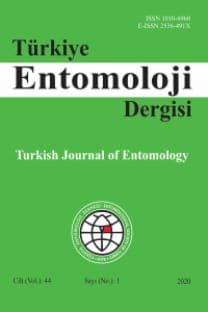Hatay ili turunçgillerinde zararlı Pseudococcus cryptus Hempel (Hemiptera: Pseudococcidae)’un yayılışı, konukçuları ve doğal düşmanları
Hatay turunçgil alanlarında Pseudococcus cryptus Hempel (Hemiptera: Pseudococcidae)’un tanınması, yayılışı, konukçuları, zarar şekli ve doğal düşmanları ortaya konmuştur. Çalışma sonucunda, P. cryptus 1997 yılında sadece Samandağ ilçesi turunçgil alanlarında %15.43 oranında görülürken, 2010’da Antakya’da %55.78, Dörtyol (Payas)’da %14.67, İskenderun’da %11.63 ve Samandağ’da %30.61 oranında bulaşma olduğu belirlenmiştir. P. cryptus’un konukçuları arasında 11 familyaya bağlı 17 bitki türü bulunmuştur. P. cryptus kolonileri turunçgillerin gövde, sürgün, yaprak ve meyvelerine yerleşerek emgi yapmakta, bu sırada damlacıklar halinde ballı madde çıkarmakta, şiddetli düzeyde fumajin oluşumu, yaprak ve meyve dökülmesine yol açmaktadır. Predatör olarak Cunaxa pothensis Den Heyer, Nephus includens Kirsch., N. (Sidis) heikei, N. (Sidis) caneparii, N.nigricans, Oenopia (Synharmonia) conglobata (L.), Scymnus (Pullus) araraticus Khnzorian, S. (P.) subvillosus, S. (P.) flagellisiphonatus, Cryptolaemus montrouzieri Muls., Chilocorus bipustulatus L., Exochomus quadripustulatus L., Cardiastethus nazarenus Reuter, Sympherobius (S.) fallax Navas, Dichochrysa prasina (Burmeister), Chrysopa viridana Schneider ve Chrysoperla carnea (Stephens) belirlenmiştir. Parazitoit türler ise Anagyrus pseudococci Gir., Leptomastidea abnormis Gir., Clausenia purpurea Ishii ve Pachyneuron muscarum L.’ dur. Sözkonusu fitofag türün öteki turunçgil alanlarına yayılmaması için gerekli iç karantina önlemlerinin alınması; bulaşmanın görüldüğü alanlarda ise geniş etkili pestisit kullanımından kaçınılarak entegre savaş ilkeleri doğrultusunda uygulamalar yapılması, doğal düşmanlarından özellikle C. purpurea ve C. montrouzieri’nin bu böceğin görüldüğü yörelere salınması ve yerleştirilmesinin yararlı olacağı vurgulanmıştır.
Hatay ili turunçgillerinde zararlı Pseudococcus cryptus Hempel (Hemiptera: Pseudococcidae)'un yayılışı, konukçuları ve doğal düşmanları
Description, distribution, host plants, type of damage and natural enemies of Pseudococcus cryptus Hempel (Hemiptera: Pseudococcidae) were revealed in Hatay citrus plantations. Citrus plantations were infested by P. cryptus at the ratios of 55.78%, 14.67%, 11.63% and 30.61% in Antakya, Dörtyol (Payas), İskenderun and Samandağ, respectively in 2010, whilst only Samandağ was infested at 15.43%, in 1997. Seventeen species belong to 11 families were determined as host plants of P. cryptus. Active stages of P. cryptus, causes honeydew during sucking the plant juice from leaves, twigs, fruits and trunks of citrus trees. Damage to citrus trees has been associated with leaves and fruit drops, with unsightely apperance of fruits due to severe honeydew on which sooty mold develops. Cunaxa pothensis Den Heyer, Nephus includens Kirsch., N. (Sidis) heikei, N. (Sidis) caneparii, N.nigricans, Oenopia (Synharmonia) conglobata (L.), Scymnus (Pullus) araraticus Khnzorian, S. (P.) subvillosus, S. (P.) flagellisiphonatus, Cryptolaemus montrouzieri Muls., Chilocorus bipustulatus L., Exochomus quadripustulatus L., Cardiastethus nazarenus Reuter, Sympherobius (S.) fallax Navas, Dichochrysa prasina (Burmeister), Chrysopa viridana Schneider and Chrysoperla carnea (Stephens) were found as predatory species. Parasitoids of P. cryptus were Anagyrus pseudococci Gir., Leptomastidea abnormis Gir., Clausenia purpurea Ishii and Pachyneuron muscarum L. Quarantine measures should be emphasized to prevent the dispersion of the pest to citrus plantations where P. cryptus is not known to occur. In infested areas, release and/or establishment of the main natural enemies, C. purpurea and C. montrouzieri would be recommended; meanwhile application of broad spectrum pesticides should be avoided.
